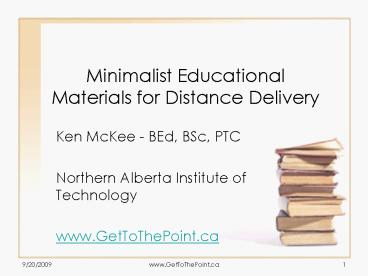Minimalist Educational Materials for Distance Delivery - PowerPoint PPT Presentation
1 / 21
Title:
Minimalist Educational Materials for Distance Delivery
Description:
Materials make or break technology solutions. No teacher in sight ... Return to romanticism with the added advantage of classified ideas and relevant technique ... – PowerPoint PPT presentation
Number of Views:98
Avg rating:3.0/5.0
Title: Minimalist Educational Materials for Distance Delivery
1
Minimalist Educational Materials for Distance
Delivery
- Ken McKee - BEd, BSc, PTC
- Northern Alberta Institute of Technology
- www.GetToThePoint.ca
2
Minimalism / Education
- I hear, I forget
- I see, I remember
- I do, I understand
- Confuscious
- Education should be useful.
- If it is not, what is it?
- Whitehead
3
Overview
- Traditional delivery problems
- Distance delivery problems
- How does Learning occur?
- What is Education?
- What is Minimalism?
- Minimalist Solutions
4
Traditional Delivery Problems
- Books
- Too thick
- Not directly applicable
- Students
- Very busy with time restraints
- Dont, wont, cant read
- Technology
- More time requirements
- Different platforms
5
Problems with Traditional Delivery
- Teachers
- Lecture
- Control concerns
- Class size, ability levels, interest
- Content applicability
6
Distant Delivery Problems
- Materials make or break technology solutions
- No teacher in sight
- Technology to overcome
- Texts too thick, where do I look?
- Questions via email can be numerous
7
What is Education?
- Education is the acquisition of the art of the
utilization of knowledge Whitehead - "Develop the best pedagogy you can. See how well
you can do. Then analyze the nature of what you
did that worked." Jerome Bruner
8
Who decides what is usable?
- Students should experience the joy of discovery
and understand the application here and now in
the circumstances of his/her life.
Whitehead - Appreciation by use
- The external connections of the subject drag
thought outwards
9
- Ideas, which are not utilized, are positively
harmful (inert) Whitehead
10
- The problem of keeping knowledge alive, of
preventing it from becoming inert, is the central
problem of all education. Whitehead
11
- Education is the evocation of curiosity, of
judgment, of the power of mastering a complicated
tangle of circumstances, the use of theory in
giving foresight in special cases
12
Romance Stage of Education
- First stage of apprehension
- Appreciation of connections
- Education must essentially be a setting in order
of a ferment already stirring in the mind
13
Precision Stage of Education
- Represents an addition to knowledge
- Analyzing the facts, bit by bit
14
Generalization Stage of Education
- Return to romanticism with the added advantage of
classified ideas and relevant technique
15
What is Minimalism?
- Brevity of materials
- www.GetToThePoint.ca
- Materials that work and work well
- Self paced
- Applicable
16
Minimalist Solutions
- Create the best applied materials you can
- Work as if you were a student
- Test the materials with students
- Questions indicate areas to adjust
- Rework, test materials again
- Could students write an introduction at end of
chapter? - Rework, test, rework, test
17
Minimalist Strategies
- All learning tasks should be meaningful and self
contained - Learners should be given realistic projects ASAP
- Instructions permit self-directed reasoning and
improvising - Increase the number of active learning activities
18
Minimalist Strategies
- Training materials and activities should provide
for error recognition and recovery - Close linkage between the training and the actual
system (job) - Minimize instructional materials which obstruct
learning
19
Applying Minimalist Principals
- Action centered tasks
- Focus on what user needs
- Omit long introductions
- Omit repetition and verbiage
- Exploit what user already knows
- Rely on users to think and improvise
20
References
- Carroll, J.M. 1990. The Nurnberg Funnel
- Carroll, J.M. 1998. Minimalism Beyond the
Nurnberg Funnel - Eiler, M.A. 1997. Minimalism and Documentation
Downsizing - Reddish, J. 1999. A Practical Guide to Useability
Testing - Reddish, J. 1999. Building usability into your
documentation, Interfaces and websites - Whitehead, A.N. 1929. The Aims of Education
21
Minimalist Websites and Links
- Minimalism (J. Carroll)http//tip.psychology.org
/carroll.htmlhttp//dabcc-www.nmsu.edu/bis/comtec
/RC/carroll/ - Minimalism and Documentationhttp//english.ttu.e
du/kairos/3.1/reviews/eiler/minimal.html - Cognitive Approaches to Instructional
Designhttp//carbon.cudenver.edu/bwilson/traini
ng.html - Achieving Minimalism Through Interactive
Multimediahttp//www.stc.org/51stConf/sessionMat
erial/dataShow.asp?ID137 - Technical Writers of India (TWIN)http//www.twin
-india.org/Minimalism.html - Usability Testing http//www.usability.gov
http//stcsig.org/usability































